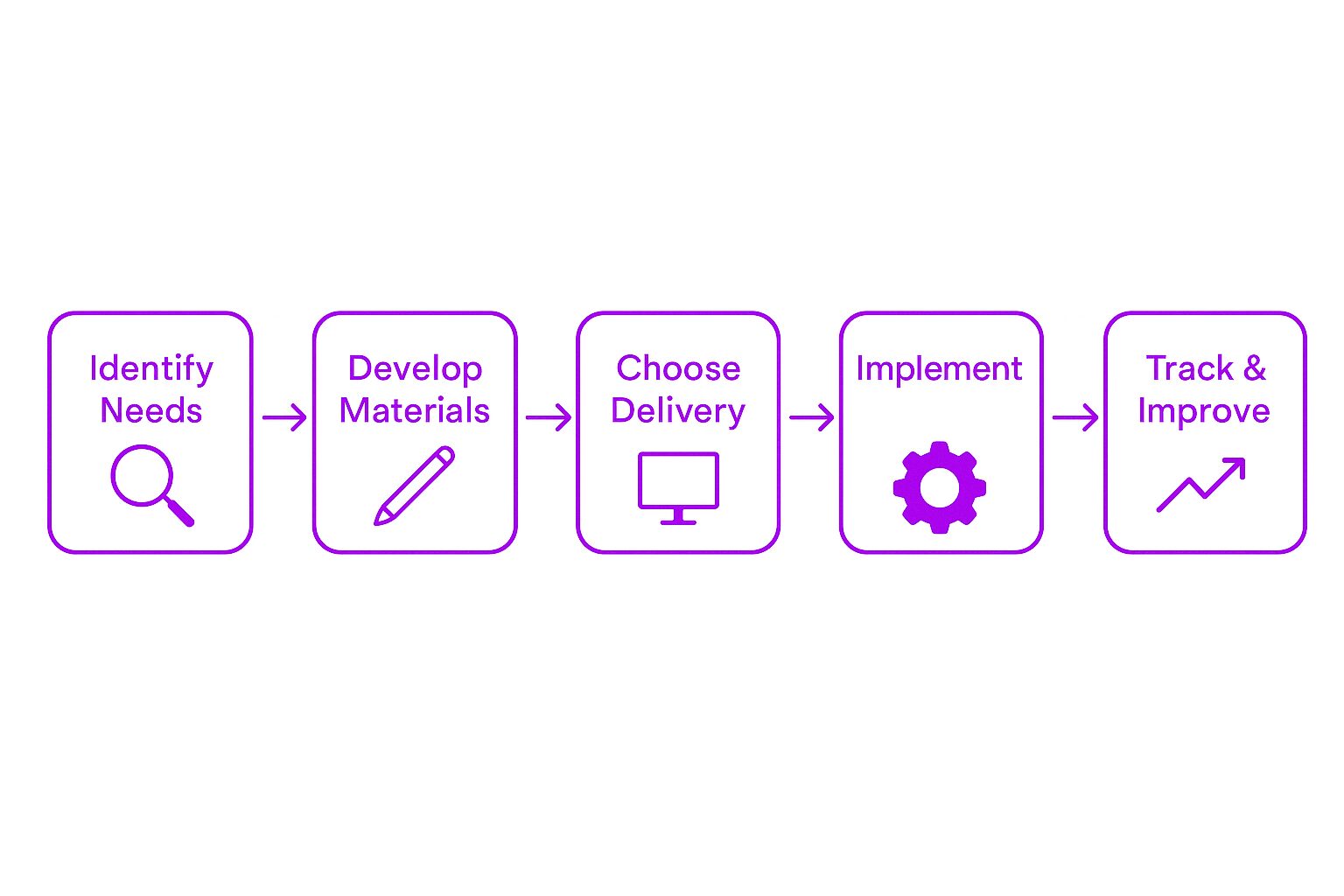What is Employee Training?
Employee training is the process of equipping employees with the knowledge, skills, and tools they need to perform their jobs effectively. It helps employees stay up to date with industry standards, company policies, and evolving job roles. Unlike employee development, which focuses on long-term career growth, training is often task-oriented and designed to improve specific skills. A comprehensive development program can complement task-oriented training by addressing long-term skill gaps and career growth.
Why Employee Training Matters
Companies that invest in training see higher productivity, better employee engagement, and improved retention. Training ensures employees can handle their responsibilities with confidence, reducing errors and increasing efficiency. Without proper training, businesses risk high turnover, poor performance, and a disengaged workforce.
Types of Employee Training
Onboarding Training
New hires need guidance to understand company culture, expectations, and workflows. Onboarding training introduces them to their roles, team members, and organizational goals. A strong onboarding process helps new employees become productive faster.
Technical or Skill-Based Training
Employees often require specialized training to use tools, software, or equipment. Technical training is crucial in equipping employees with the necessary hard skills to effectively use enterprise applications and succeed in their roles. In IT, for example, developers learn new coding languages, while healthcare professionals update their knowledge of medical procedures.
Soft Skills Training
Interpersonal skills are as important as technical skills. Communication, leadership, teamwork, and problem-solving training help employees collaborate and work effectively with colleagues and clients.
Product Training
Customer-facing employees need thorough knowledge of the products or services they represent. Product training ensures they can answer customer questions confidently and provide accurate recommendations.
Additionally, customer service training is essential for equipping employees with the skills and knowledge needed to deliver exceptional customer service.
Sales Training
Sales teams benefit from training that improves persuasion, negotiation, and customer relationship skills. Effective sales training can lead to higher revenue and customer satisfaction.
Leadership Training
Organizations looking to promote from within must invest in leadership training. Future managers need guidance on team management, decision-making, and conflict resolution.
eLearning and Digital Training
Online learning platforms allow employees to access training at their own pace. Online courses play a crucial role in providing engaging and interactive content that facilitates learning within the flow of work. Digital courses, webinars, and virtual workshops provide flexibility and accommodate different learning styles.
Safety and Compliance Training
Industries with strict regulations, such as manufacturing, construction, and finance, require compliance training. Employees must understand safety protocols and legal requirements to prevent violations and workplace accidents.
Diversity, Equity, and Inclusion (DEI) Training
Workplace diversity training fosters an inclusive environment. It helps employees recognize biases, improve collaboration, and create a culture of respect.
Benefits of Employee Training
Higher Productivity
Employees who know what they are doing work more efficiently, and proper training not only reduces mistakes but also enhances overall employee performance. Proper training reduces mistakes and increases overall output.
Lower Turnover
Employees stay with companies that invest in their growth. Training builds job satisfaction and loyalty.
Better Workplace Culture
When employees feel competent and confident, workplace morale improves. A well-trained workforce fosters collaboration and teamwork.
Improved Customer Experience
Trained employees deliver better service. Whether in sales, support, or operations, knowledgeable staff improve customer satisfaction.
Competitive Advantage
Businesses that train their employees outperform competitors. They stay ahead in industry trends, technology, and market demands.
Challenges in Employee Training
High Costs
Developing training programs, hiring trainers, and purchasing software can be expensive. Small businesses may struggle with budget constraints.
Engagement and Retention Issues
Not all employees engage with training. Without interactive methods, training can feel tedious, leading to poor retention of information.
Keeping Training Relevant
Industries evolve, and training must keep up. Identifying and addressing knowledge gaps through needs assessments is crucial for keeping training relevant and effective. Outdated materials can hinder employee progress instead of helping them adapt.
Measuring Training Effectiveness
Assessing the impact of training is difficult. Companies need clear metrics to determine whether employees apply what they learn.
Creating an Effective Training Program
Identify Training Needs
Before designing a program, companies must assess skill gaps. Surveys, performance reviews, and employee feedback help determine what training is needed. Comprehensive development programs can be tailored to address specific skill gaps identified through needs assessments.
Develop Engaging Training Materials
Training should be interactive and engaging. Videos, case studies, and hands-on activities improve retention compared to lectures or static manuals.
Choose the Right Delivery Method
Not all employees learn the same way. Classroom training, as an instructor-led format, can be part of a broader blended learning approach to enhance overall employee development. A mix of in-person training, online modules, and peer learning accommodates different preferences.
Implement the Program
Scheduling training sessions, setting learning objectives, and ensuring accessibility are key to successful implementation.
Track and Improve Training
Companies should measure progress through assessments, feedback, and performance tracking. Adjusting training content based on employee responses ensures continuous improvement.
Best Practices for Employee Training
Make Training a Continuous Process
Learning should not stop after onboarding. Companies that offer ongoing training help employees grow and adapt. Continuous workplace training fosters a culture of learning, enhancing employee skills and supporting compliance with industry regulations.
Encourage Participation
Engaged employees retain more information. Gamification, incentives, and group discussions make training more interactive.
Personalize Training
Tailored programs based on job roles, experience levels, and learning styles make training more effective. Creating personalized and engaging learning experiences facilitates skill acquisition and application.
Use Technology
Online learning platforms, mobile training apps, and AI-driven recommendations make learning more accessible and engaging.
Provide Real-World Applications
Employees learn best when training applies to their daily tasks. Case studies, simulations, and role-playing exercises help bridge the gap between theory and practice.
Emerging Trends in Employee Training
AI-Powered Learning
Artificial intelligence can analyze employee progress and suggest personalized training paths based on individual needs.
Gamification
Adding game-like elements, such as rewards, challenges, and leaderboards, makes learning fun and competitive.
Virtual and Augmented Reality
VR and AR training provide hands-on experience in a controlled environment. Industries like healthcare and manufacturing use VR simulations for real-world practice.
Microlearning
Short, focused training sessions help employees retain information better. Microlearning delivers content in small, digestible chunks. This approach enhances the learning experience by making training more engaging and effective.
Real-World Examples of Employee Training
IBM’s AI-Powered Learning
IBM uses AI-driven training platforms that recommend personalized learning paths based on employee skills and interests.
Facebook’s Engineering Bootcamp
New engineers at Facebook go through a bootcamp where they rotate between projects before selecting a permanent team. This hands-on approach accelerates learning.
Starbucks Coffee Master Program
Starbucks provides specialized employee training programs, such as the Coffee Master Program, for employees who want to deepen their knowledge of coffee and customer service. This program enhances product expertise and employee engagement.
Gamified Training at Deloitte
Deloitte uses gamified learning modules to make compliance and leadership training more engaging.
Employee training is a crucial investment. Companies that prioritize training create a skilled workforce, reduce turnover, and maintain a competitive edge.







